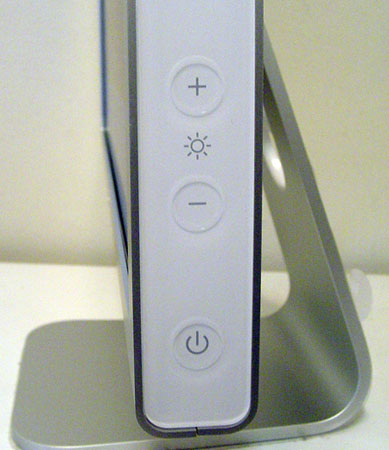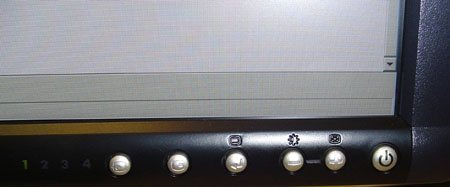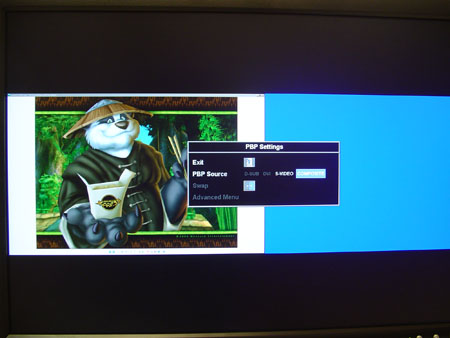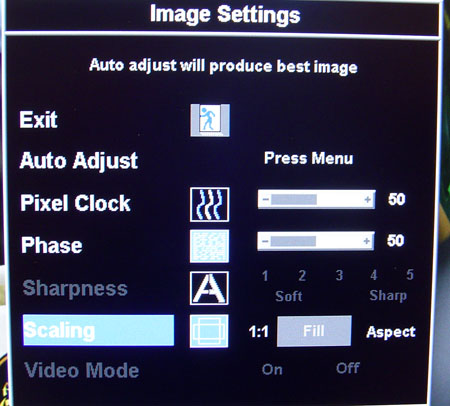The 20" LCD Shootout: Dell versus Apple
by Kristopher Kubicki on April 27, 2005 12:05 AM EST- Posted in
- Displays
User Interface
Apple and Dell are very different with regard to how they approach technology. The ever conservative Dell would rather not change things, particularly things that work, while Apple seems to enjoy completely changing everything in every iteration of any technology. Neither one of these strategies is bad, nor wrong. Dell has thousands of consumer-hardened products under its belt while Apple has thousands of design and creativity awards. Apple does make things pretty easy for us. There are only three options: on/off, brighter or darker.The touch sensitive controls give the Cinema 20” a feel that can only be described as “Mac-esque” while still retaining enough functionality on the display to not be totally removed from its operation (like with the Samsung 193P). Ultimately, one of the reasons why sales of the SyncMaster 193P stagnated for several months was due to the fact that users don’t particularly like giving up 100% of their control features to the OS. With digital signal, a user can only really affect the backlight intensity anyway – and fortunately, Apple gives us control of that. Although simple, the Cinema 20” gives a good balance of control.
However, when you have four inputs, three of which are analog, user control is almost absolutely necessary. From left to right, the buttons on the Dell 2005FPW are identified as such: Input Select, Picture In Picture, Menu, Adjust down, Adjust up, and Power.
Most of these are basically transplanted from the Dell 2001FP. The 2005FPW and 2001FP utilize the same inputs and, more or less, behave in the same manner with input selection. The real kicker to us came when we started playing around with the Picture In Picture button. Not only does Dell give us the opportunity to place an analog signal (S-Video, Composite) inside a D-sub or DVI signal, but they also allow us to go one step further and split screen (PBP - picture by picture) it as well! We lose a lot of desk space, but since the image can be swapped very quickly or screened from the control buttons, it is still very practical.
The other key feature in the Dell 2005FPW interface is the scaling selector. Under Image properties in the Dell OSD, we were allowed to modify the scaling to 1:1 (excellent for gamers), Fit, or Aspect.














70 Comments
View All Comments
Weezard - Wednesday, May 4, 2005 - link
Okay, sounds good.So if I buy this monitor, Ill just have to plug it in, and it will work with widescreen and all - on my Windows XP system with 9700Pro?
Thanks.
Pastuch - Wednesday, May 4, 2005 - link
"Does my Radeon9700Pro support this monitor?"A 9700pro is an excellent videocard for this monitor if you dont plan on playing games like Halflife 2 or WoW. The 9700pro's DVI signal will work perfectly, however you should install the latest ATI driver from ATI.com.
"but what about resolution options, DDC (or what its called - the function that delivers 16:10 widescreen). "
DDC or whatever you had in mind does not deliver a widescreen display. If you install the latest ATI drivers you will see that the standard windows graphics profiles in display settings have 1680x1050x32. The ATI driver has the ability to force 720p or 1080i but it is not necessary.
Weezard - Wednesday, May 4, 2005 - link
Hi, nice review.I do have a few questions about the Cinema Display.
Does my Radeon9700Pro support this monitor? It has DVI output, but what about resolution options, DDC (or what its called - the function that delivers 16:10 widescreen).
Is this a plug and play monitor, when running Windows XP and Radeon 9700Pro? Is any software needed before using it with a Windows OS?
Thank you.
wrack - Wednesday, May 4, 2005 - link
One thing I forgot to ask Kristopher,Which graphics card and processor was used to carry out this review..? I can't find 1680x1050 resolution option on my graphics card.
wrack - Tuesday, May 3, 2005 - link
#54 Electonic circuits always tend to attract fine dust.nortexoid - Sunday, May 1, 2005 - link
dust acts as an insulator? the monitor is standing vertically so the only place dust would gather is on the top, not on any of the electronics. or do you lie your monitor face down on a glass desk and work from underneath the desk? i know it's gaining ergonomic popularity, but i thought only in malawi.Spacecomber - Saturday, April 30, 2005 - link
This is the kind of review that I'd like to see become the standard for comparing LCDs. Pick an assortment of LCDs that are using the same type of matrice panel(TN, IPS, PVA/MVA) and compare these monitors to each other. They don't have to be using the exact same panel, as in this case, just one based on the same technology. This will provide the reader with something much more like an apples to apples comparison than the apples to oranges comparision that you will get otherwise. (Sorry, about the Apple pun.)With all three (or four) types of matrices having such distinctive strengthes and weaknesses, you pretty much have to decide which of these patterns of characteristics will best match how you use the computer and then go looking for that particular type of matrice in a panel.
The questions for the reviewers then becomes how well does a particular display cope with it's inherent weaknesses, as well as how well does it emphasize what should be its relative strengths.
For example, in this Anandtech review of IPS panel displays, one of the main problems for IPS panels to overcome is a relatively low contrast ratio, which can affect how well it reproduces black; so, this specification is one that should be given particular attention in the review, especially the subjective analysis.
Response times are always a point of emphasis in LCD reviews, and with IPS screens, as was noted in the review, you should expect to see the relatively modest black-white response time made up for by the fact that response times stay relatively consistent, even when changes in shade become smaller. (That is why I was confused by this statement, regarding motion blur, in the review, "...two states that are very close to each other take less time than two states further apart from each other, which results in pixels that are not just delayed in a uniform manner, but at several different speeds across the entire panel depending on the hue". I thought that it was with states that were closer together that you saw the slower response time, due to the voltage differential being so small in these cases.)
In sum, I'd like to see more LCD reviews start with what is known about the panel that is being used (such as is detailed in this very good xbitlabs analysis, http://www.xbitlabs.com/articles/other/display/lcd... and use this understanding to provide a framework for comparing LCDs in terms of their strengths and weaknesses. Essentially, while there is no one LCD monitor that is as well rounded for many purposes as is a CRT, anyone buying a LCD will be looking for the one that imposes fewer compromises on the them and for compromises that impinge less on how the screen will be used by that particular buyer.
Space
KristopherKubicki - Friday, April 29, 2005 - link
nortexoid: Dust acts as an insulator. Wrapping your DSP in a warm cuddly blanket will probably make it fail prematurely.glennpratt: Unfortunately I cannot quite vouche for the fact that aluminum really acts as a heat sink on this display. The housing is completely smooth and does not really create additional surface area for heat dissapation. Aluminums ability to transfer heat well only helps if there is additional surface area for the sink to come in contact with air.
In reality, the reason why Apple can get away with a beveled design without any passive exhaust has more to do with the fact that the inverter is housed in a separate brick from the display. Samsung does this too in many of their high end displays.
Anyways - I think Apple just picked Aluminum for looks.
Kristopher
glennpratt - Friday, April 29, 2005 - link
The Apple is made of aluminum which may have affected their decision to leave out the vents (aluminum transfers heat much better the plastic.)nortexoid - Thursday, April 28, 2005 - link
What do you think damages a electronics more: dust falling on them or high temperatures?I'd rather vents in the back of my monitor to prevent higher temperatures than have it completely sealed to keep out that horribly destructive nuclear fallout.